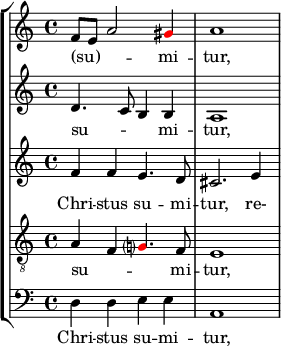
Excerpt from O sacrum convivium by Thomas Tallis. The courtesy accidental on the tenor's G natural is editorial.
In classical music theory, the English cadence is a contrapuntal pattern particular to the authentic or perfect cadence. It features a flattened seventh scale degree against the dominant chord,[1] which in the key of C would be B♭ and G–B♮–D.
Popular with English composers of the High Renaissance and Restoration periods in the sixteenth and seventeenth centuries, the English cadence is described as archaic[2] or old-fashioned[3] sounding. It was first given its name in the twentieth century.
The hallmark of this device is the dissonant augmented octave (compound augmented unison) produced by a false relation between the split seventh scale degree.
- ^ van der Merwe, Peter (2005). Roots of the Classical: The Popular Origins of Western Music, p. 492. ISBN 0-19-816647-8.
- ^ Carver, Anthony (1988). The Development of Sacred Polychoral Music to the Time of Schütz, p. 136. ISBN 0-521-30398-2. If the clash cadence is already, "archaic, [and/or] mannered," in the music of Heinrich Schütz (1585-1672) it must surely be so now.
- ^ Herissone, Rebecca (2001). Music Theory in Seventeenth-Century England, p. 170. ISBN 0-19-816700-8.